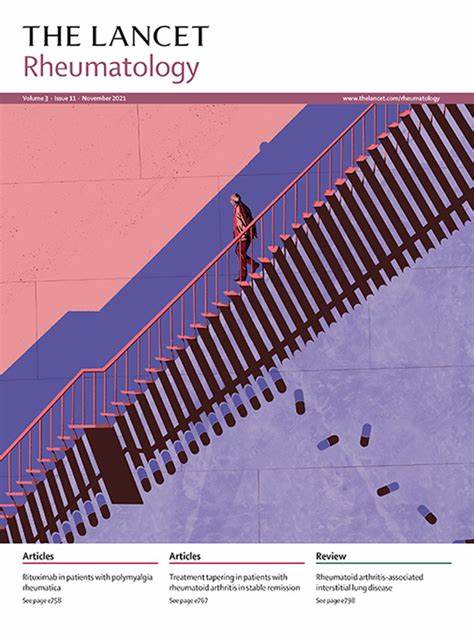Personalised gait retraining for medial compartment knee osteoarthritis: a randomised controlled trial
IF 16.4
1区 医学
Q1 RHEUMATOLOGY
引用次数: 0
Abstract
Background
Retraining individuals with medial compartment knee osteoarthritis to walk with a patient-specific change in their foot angle (ie, toe-in or toe-out angle) can reduce excessive joint loading related to disease progression. This study investigated the clinical, biomechanical, and structural efficacy of personalised foot progression angle modifications compared with sham treatment in patients with mild-to-moderate medial compartment knee osteoarthritis.
Methods
In this single-center, parallel-group, randomised controlled trial, we recruited individuals with symptomatic medial compartment knee osteoarthritis at the Human Performance Laboratory and Lucas Center for Imaging at Stanford University, CA, USA, using online and print media. Eligible participants (aged ≥18 years) were randomly assigned (1:1) by a computer to an intervention or sham group. During six walking retraining visits to a university gait laboratory, all participants received real-time biofeedback instructing them to walk consistently with a personalised target foot progression angle. The intervention group's target was the 5° or 10° change in foot progression angle that maximally reduced their knee loading, and the sham group's target was their natural foot progression angle. Participants and staff involved in data analysis were masked to group allocation; staff performing the gait analysis visits were not. Primary outcomes were 1-year changes in medial knee pain (numeric rating scale) and medial knee loading (knee adduction moment peak). Secondary outcomes were 1-year changes in cartilage microstructure estimated from MRI (T1ρ and T2 relaxation times). We evaluated safety by monitoring the number and type of adverse events. Intention-to-treat linear regression analyses, comprising all randomly assigned participants, were conducted. People with lived experience of knee osteoarthritis were involved in the design and conduct of this study. This study is registered with ClinicalTrials.gov, NCT02767570, and is closed to enrollment.
Findings
Between Aug 1, 2016, and June 25, 2019, 1582 individuals were screened for eligibility. 107 participants completed an initial gait analysis and 68 were randomly assigned to either the intervention (n=34) or the sham (n=34) group. 41 (60%) of 68 participants were female, 27 (40%) were male, and 54 (79%) were White; mean age was 64·4 years (SD 7·6). After 1 year, participants in the intervention group had greater reductions in medial knee pain (between-group difference –1·2, 95% CI –1·9 to –0·5; p=0·0013) and knee adduction moment peak (between-group difference –0·26 % bodyweight × height, 95% CI –0·39 to –0·13; p=0·0001) than participants in the sham group. The MRI-estimated change in cartilage microstructure (T1ρ) in the medial compartment was less in the intervention group than the sham group (between-group difference –3·74 ms, 95% CI –6·42 to –1·05). There were no significant between-group differences in T2. There were no severe adverse events; however, two (6%) of 34 participants in the intervention group and one (3%) of 34 participants in the sham group dropped out of the study due to increased knee pain.
Interpretation
Personalised foot angle modifications improve pain, reduce knee loading, and might slow osteoarthritis progression, making them a promising non-surgical treatment option for some individuals with medial compartment knee osteoarthritis.
Funding
US Department of Veterans Affairs.
个性化步态再训练治疗内侧室膝骨关节炎:一项随机对照试验。
背景:对患有内侧室膝骨关节炎的患者进行再训练,使其改变患者特定的足角(即脚趾向内或脚趾向外的角度),可以减少与疾病进展相关的过度关节负荷。本研究探讨了与假治疗相比,个体化足部进展角度改变对轻度至中度内侧室膝骨关节炎患者的临床、生物力学和结构效果。方法:在这项单中心、平行组、随机对照试验中,我们招募了美国斯坦福大学人类行为实验室和卢卡斯成像中心的症状性内侧室膝关节骨关节炎患者,使用在线和印刷媒体。符合条件的参与者(年龄≥18岁)由计算机随机(1:1)分配到干预组或假手术组。在大学步态实验室进行的六次步行再训练中,所有参与者都收到了实时生物反馈,指导他们始终以个性化的目标足部前进角度行走。干预组的目标是最大限度地减少膝关节负荷的足向前角变化5°或10°,假手术组的目标是足向前角的自然变化。参与数据分析的参与者和工作人员对分组分配不知情;进行步态分析访问的工作人员则没有。主要结局是1年内膝关节内侧疼痛(数值评定量表)和膝关节内侧负荷(膝关节内收力矩峰值)的变化。次要结果是通过MRI (T1ρ和T2松弛时间)估计软骨微观结构的1年变化。我们通过监测不良事件的数量和类型来评估安全性。意向治疗线性回归分析,包括所有随机分配的参与者。有膝骨关节炎生活经验的人参与了这项研究的设计和实施。该研究已在ClinicalTrials.gov注册,编号NCT02767570,并已结束入组。研究结果:在2016年8月1日至2019年6月25日期间,1582人被筛选为合格。107名参与者完成了最初的步态分析,68名参与者被随机分配到干预组(n=34)或假手术组(n=34)。68名参与者中女性41人(60%),男性27人(40%),白人54人(79%);平均年龄为64.4岁(SD为7.6)。1年后,干预组的参与者在内侧膝关节疼痛方面有更大的减轻(组间差异-1·2,95% CI -1·9至-0·5;p= 0.0013)和膝关节内收力矩峰值(组间差异- 0.26%体重×身高,95% CI - 0.39 ~ - 0.13;P =0·0001)高于假手术组。干预组mri估计的内侧室软骨微观结构(T1ρ)变化小于假手术组(组间差异-3·74 ms, 95% CI -6·42 ~ -1·05)。T2组间差异无统计学意义。无严重不良事件发生;然而,干预组34名参与者中有2名(6%)退出研究,假手术组34名参与者中有1名(3%)退出研究,原因是膝关节疼痛加重。解释:个体化的足角调整可以改善疼痛,减轻膝关节负荷,并可能减缓骨关节炎的进展,使其成为一些内侧室膝骨关节炎患者的一种有希望的非手术治疗选择。资助:美国退伍军人事务部。
本文章由计算机程序翻译,如有差异,请以英文原文为准。
求助全文
约1分钟内获得全文
求助全文
来源期刊

Lancet Rheumatology
RHEUMATOLOGY-
CiteScore
34.70
自引率
3.10%
发文量
279
期刊介绍:
The Lancet Rheumatology, an independent journal, is dedicated to publishing content relevant to rheumatology specialists worldwide. It focuses on studies that advance clinical practice, challenge existing norms, and advocate for changes in health policy. The journal covers clinical research, particularly clinical trials, expert reviews, and thought-provoking commentary on the diagnosis, classification, management, and prevention of rheumatic diseases, including arthritis, musculoskeletal disorders, connective tissue diseases, and immune system disorders. Additionally, it publishes high-quality translational studies supported by robust clinical data, prioritizing those that identify potential new therapeutic targets, advance precision medicine efforts, or directly contribute to future clinical trials.
With its strong clinical orientation, The Lancet Rheumatology serves as an independent voice for the rheumatology community, advocating strongly for the enhancement of patients' lives affected by rheumatic diseases worldwide.
 求助内容:
求助内容: 应助结果提醒方式:
应助结果提醒方式:


